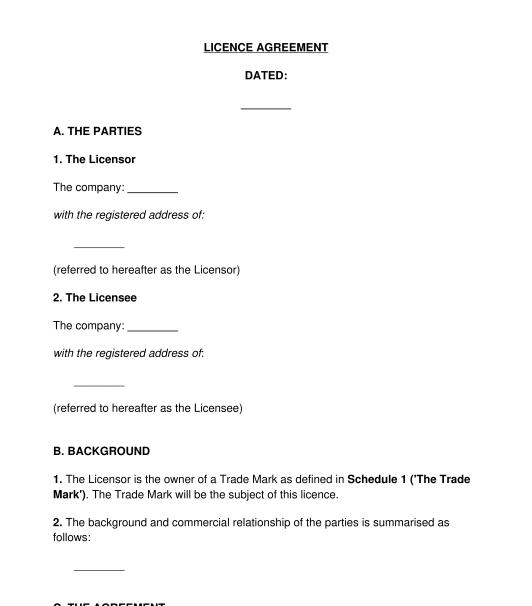 24/09/2025
24/09/2025

Answer a few questions and your document is created automatically.

Your document is ready! You will receive it in Word and PDF formats. You will be able to modify it.

 24/09/2025
24/09/2025
 Word and PDF
Word and PDF
 16 to 22 pages
16 to 22 pages



This document can be used by the registered owner of a brand (the licensor) to grant a licence to another person or entity (the licensee) to enable the licensee to use the licensor's trade marks. The licnce agreement is designed for use where the parties are based in the United Kingdom. It can be used for up to three trade marks in total.
A trade mark is a sign which is used by a business to represent its brand and products. A trade mark may take many different forms. For example, a trade mark may consist of:
It is common for a business to register its trade marks, as this can assist in protecting and enforcing the trade marks. A trade mark may be registered in the United Kingdom via the UK Intellectual Property Office. A trade mark may also be registered in other countries via:
When a trade mark is licensed, the licensor will retain their ownership of the trade mark but will grant the licensee the right to use the trade mark in certain ways, and on certain products. An owner of a trade mark may wish to grant a licence for a number of reasons, such as:
The licence can define the relevant factors of the parties' agreement in respect of the licence, such as:
How to use this document
Both parties should have had discussions in order to confirm the key points which have been agreed upon. This process may have involved a letter of intent. Once the document has been completed with the relevant information, both parties should provide a dated signature to the agreement in the space provided.
The way in which a party will sign the document will depend upon its business structure. The document may be signed:
Both parties should retain a version of the licence agreement which has the signature of both parties on it. The agreement will be effective from the start date which has been selected. Where any issues arise in respect of any breaches to the agreement, the aggrieved party may wish to send a formal notice to the other party.
Relevant law
The primary piece of law which relates to UK registered trade marks is the Trade Marks Act 1994.
The Trade Mark Rules 2008 (SI 2008/1797) set out the relevant procedures applicable to the registration of trade marks.
Unregistered trade marks are governed by common law.
Further information about trade marks may be found on the UK government website.
How to modify the template
You fill out a form. The document is created before your eyes as you respond to the questions.
At the end, you receive it in Word and PDF formats. You can modify it and reuse it.
A guide to help you: Signing Documents in England and Wales
Trade Mark Licence Agreement - Template - Word and PDF
Country: United Kingdom